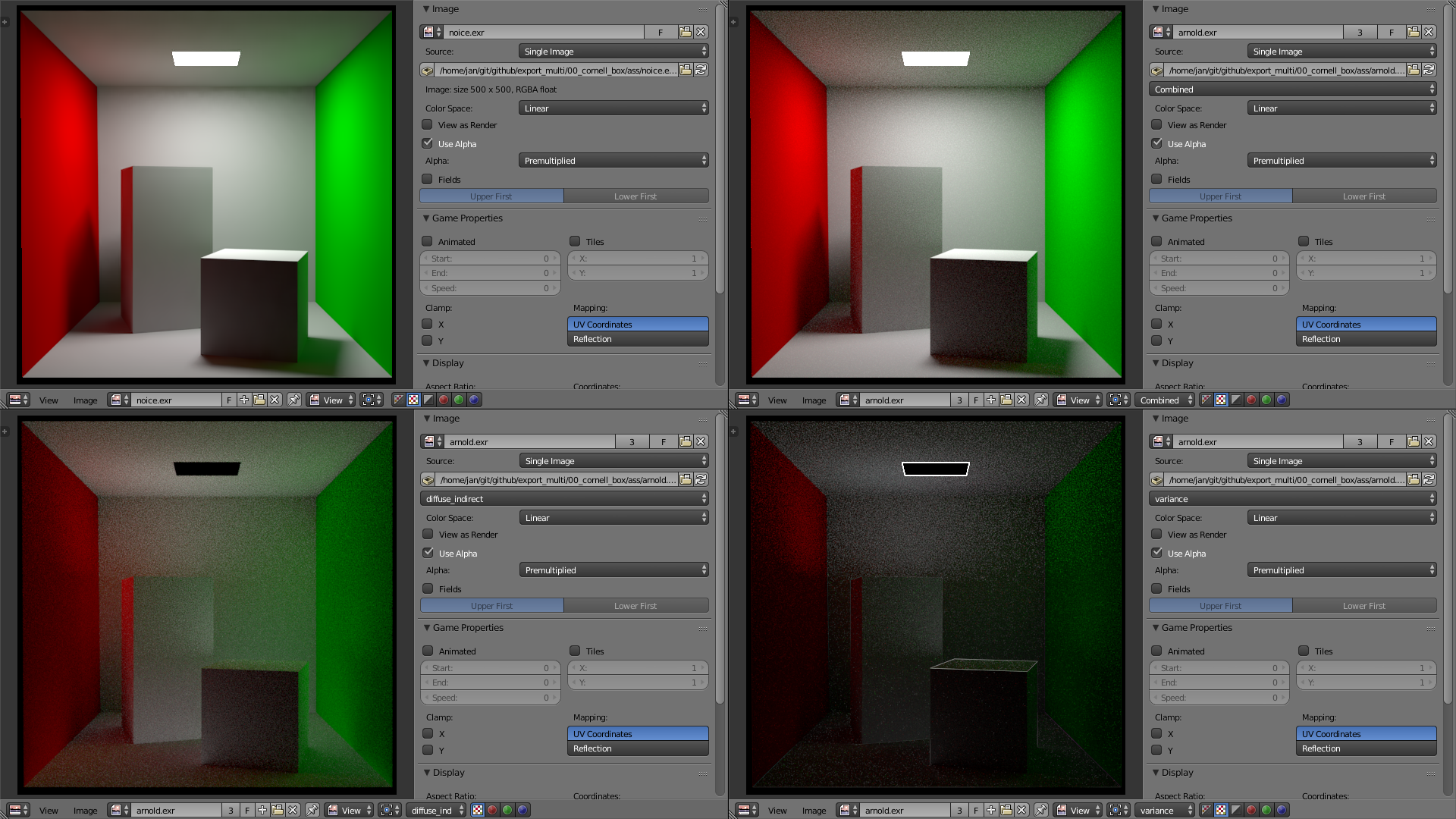Denoising
There is not so much information out there how to denoise an image with the Arnold renderer. You probably find pages like Denoising a Room Interior via Google search. Feel free to read the information provided and try to apply this to MtoA (Maya to Arnold). I will not talk about any DCC (Digital Content Creation) tool specific solutions here. I rather give an example file in Arnold’s scene description file format (.ass).
Blender
If you want to see a denoiser in action you can use the open source DCC Blender and download one of the example files I talked about in the past:
The Cornell Box scene used in this simple example should be prepared for Cycles and you can watch tiles being render if you press F12. You will notice that the tiles at the edges are still noisy until all surrounding tiles got rendered. This is when the denoiser kicks in and makes the tiles less noisy (or noise free).
Arnold
But now let’s look at Arnold and two images (within Blender):

(right click in your browser to see a larger version by selecting “view image” or “save image as…“.)
On the upper right side you see an image with AOVs (Arbitrary Output Variables). In Blender they call this AOV (or pass) Combined (see below and to the right of the image). Most other DCCs call it beauty pass. Basically there are several images stored within a single OpenEXR image. And the lower two images show you the diffuse indirect pass on the left, and the variance pass on the right. They are all part (beside other passes) of the same rendered image (called arnold.exr).
On the upper left you see the denoised image (called noice.exr). But how did we render those two images via Arnold?
export_multi
I started to collect simple scenes for my render comparisons in a GitHub repository called export_multi. The directory for the Cornell Box contains a sub directory for .ass files:
# where are we?
$ pwd
/home/jan/git/github/export_multi/00_cornell_box/ass
# what's there?
$ ls -lag
total 24
drwxr-xr-x 2 jan 4096 Jul 9 10:51 .
drwxr-xr-x 14 jan 4096 Apr 1 10:49 ..
-rw-r--r-- 1 jan 5116 Jul 8 13:06 cornell_box.ass
-rw-r--r-- 1 jan 1865 Jul 8 13:07 cornell_box_denoise.patch
-rw-r--r-- 1 jan 1037 Jul 8 12:29 Makefile
For testing the denoiser I modified an already existing cornell_box.ass file:
diff --git a/00_cornell_box/ass/cornell_box.ass b/00_cornell_box/ass/cornell_box.ass
index f144aa42..49f0f84d 100644
--- a/00_cornell_box/ass/cornell_box.ass
+++ b/00_cornell_box/ass/cornell_box.ass
@@ -9,13 +9,13 @@ options
AA_samples 5
outputs 8 1 STRING
"RGBA RGBA filter driver"
- "emission RGB filter driver_emission"
- "diffuse_direct RGB filter driver_diffuse_direct"
- "specular_direct RGB filter driver_specular_direct"
- "transmission_direct RGB filter driver_transmission_direct"
- "transmission_indirect RGB filter driver_transmission_indirect"
- "diffuse_indirect RGB filter driver_diffuse_indirect"
- "specular_indirect RGB filter driver_specular_indirect"
+ "emission RGB filter driver"
+ "diffuse_direct RGB filter driver"
+ "diffuse_indirect RGB filter driver"
+ "RGB RGB variance_filter driver variance"
+ "diffuse_albedo RGB filter driver"
+ "Z FLOAT filter driver"
+ "N VECTOR filter driver"
xres 500
yres 500
bucket_size 32
@@ -55,50 +55,14 @@ gaussian_filter
name filter
}
-driver_exr
-{
- name driver
- filename "arnold.exr"
-}
-
-driver_exr
-{
- name driver_emission
- filename "arnold_aov_emission.exr"
-}
-
-driver_exr
-{
- name driver_diffuse_direct
- filename "arnold_aov_diffuse_direct.exr"
-}
-
-driver_exr
+variance_filter
{
- name driver_specular_direct
- filename "arnold_aov_specular_direct.exr"
+ name variance_filter
+ filter_weights gaussian
}
driver_exr
{
- name driver_transmission_direct
- filename "arnold_aov_transmission_direct.exr"
-}
-
-driver_exr
-{
- name driver_transmission_indirect
- filename "arnold_aov_transmission_indirect.exr"
-}
-
-driver_exr
-{
- name driver_diffuse_indirect
- filename "arnold_aov_diffuse_indirect.exr"
-}
-
-driver_exr
-{
- name driver_specular_indirect
- filename "arnold_aov_specular_indirect.exr"
+ name driver
+ filename "arnold.exr"
}
polymesh
For convenience I provide three files here:
$ unzip -l cornell_box_denoise.zip
Archive: cornell_box_denoise.zip
Length Date Time Name
--------- ---------- ----- ----
4411 2020-07-09 10:55 cornell_box_denoise.ass
8442067 2020-07-09 10:56 cornell_box_denoise_arnold.exr
2517479 2020-07-09 10:56 cornell_box_denoise_noice.exr
--------- -------
10963957 3 files
This is the patched cornell_box_denoise.ass Arnold file for rendering and the two resulting images. The full procedure to create those images yourself is (look at the Makefile in the export_multi folder mentioned above):
$ kick -dp -dw -i cornell_box_denoise.ass -v 6 ...
# replace the '...' above by the following three options
# -set MALight_light.intensity 1
# -set MALight_light.samples 3
# -set options.GI_diffuse_samples 1
00:00:00 82MB | log started Thu Jul 9 11:05:26 2020
00:00:00 82MB | Arnold 6.0.3.1 [93beeb25] ...
...
00:00:04 93MB | Arnold shutdown
# that rendered arnold.exr with several AOVs
# now let's do the denoising:
$ noice -i arnold.exr -o noice.exr
noice 6.0.3.1 [93beeb25] - the Arnold denoiser
Using 28 threads.
Loading images...
Loading file "arnold.exr".
Using feature AOV 'diffuse_albedo' with filter 'gaussian_filter'
Using feature AOV 'N' with filter 'gaussian_filter'
Using feature AOV 'Z' with filter 'gaussian_filter'
Working with 1 frame at 500x500
Will denoise AOV "RGBA", using associated variance
Output file will be "noice.exr"
Start denoising (patch radius 3, search radius 9, variance 0.5)
Denoising RGBA
Finished denoising
Saving image noice.exr (500 x 500 x 4)
Both executables kick and noice should ship with your Arnold installation. For those of you who do not have an Arnold license, you can still inspect both .exr files (e.g. via Blender) and look at the AOVs.
